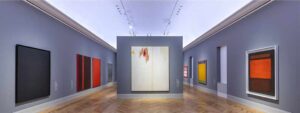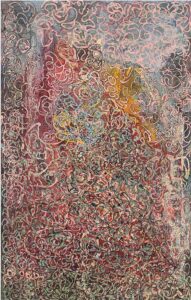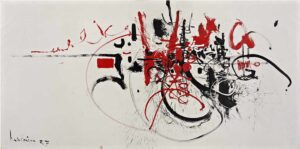Christian Hain

Hasso Plattner is a man of many passions, from computers: co-founding software giant SAP provided him with the means to become one of Europe’s top art collectors – over hockey: his ownership of NHL team San Jose Sharks might give us a hint as to where he preferably spends his holidays – to Impressionism. Among many more masterpieces of the genre, Plattner’s (foundation) Barberini Museum in Potsdam hosts the largest collection of Monet paintings outside of Paris.
Historically, and if you omit certain other important movements, Impressionism led right into abstract painting: Monet himself paved the way for example with certain versions of the Nympheas and the Pont japonais and this summer, the Barberini unites more than a hundred works of post-war Abstraction from both sides of the Atlantic.
For long, Impressionism has been something like art for beginners, meaning that it appealed to the general public and wealthy collectors alike – capturing the light and mood of a landscape view is an emotional experience almost everybody can relate to. Yet today, things are changing, the mega rich appearing more progressively minded than ever before prefer to store NFTs of dancing apes on some company’s virtual cloud, and the average Joe follows suit, thinking himself extremely cunning by investing in ‘crypto, y’know’, and collecting digital street-art. Metaverse is the new nature while Impressionism might have become an outdated pastime of the old white man. Most abstract painting on the other hand demands a certain level of visual and theoretical schooling, it has never been as accessible to everyone and not withstanding its apparent compatibility to technological aesthetics, this remains largely unchanged.
Given all that The Shape of Freedom. International Abstraction after 1945 probably doesn’t guarantee a new record attendance for the otherwise highly successful museum.
The day before the event, we received a friendly reminder for the press preview despite having RSVP’d weeks before, which is always a hint at the media interest being not as high as anticipated. Arriving at the pseudohistorical palace in the former Prussian emperor’s city of residence just outside Berlin (Berlin’s Versailles), we felt relieved to find not many seats empty in the second floor auditorium (you will inevitably miss the elevators and take the wide and impressive but also exhausting staircase, for example when visiting one of the daily lectures on art history, with a special focus on Impressionism and possibly not sparing some warm words on the collection and its mécène). Looking around however, we couldn’t escape the impression, that most colleagues had a thing in common with the exhibition title, viz. their year of creation. (Maybe a different title could have helped to attract a hipper crowd, something along the lines of Genderless Abstraction – It’s Vegan!– but I’m digressing.)
The exhibition will later travel to Oslo and Vienna, and a representative of the Albertina Modern already announced some alterations concerning the choice of artists and works and a special focus on Austrian painters but of course, just like the Munch Museum, they will stick to the general curatorial concept that starts from three works by Norman Bloom, Joan Mitchell and Sam Francis in the Plattner Collection and adds about a hundred works from major international collections (forgive my colloquiality, but who wouldn’t love to witness such a cold call only once, “Hi, it’s Hasso, mind borrowing me some of your Pollocks…? Sure, my museum guys will contact your PA for the details … and see you on the yacht, yeah: Venice, champagne is on me!” Or whatever, I don’t move in those circles).

The Shape of Freedom. International Abstraction after 1945 should not be understood as implying a continuity until today – the selection remains limited to the 20th century, which is probably a good thing: Abstraction hardly still spells artistic freedom to the same degree it did several decades ago. That title obviously carries another meaning too, referring to new hopes and a fresh start after the horrors of war and mostly German national– but also Stalinist socialism. People in charge of the exhibition explicitly include the nuclear bombings of Hiroshima and Nagasaki in the events that marked a turning point for history and art.
Curator Daniel Zamani reminds of Sam Francis, who started to paint during years of reconvalence from a war injury and other traumatized artists refusing to continue where things had stopped, then mentions a renunciation of the human shape, which upon second thought appears paradoxical – isn’t that exactly what those killers did (what every collectivist movement leads to sooner or later)? If the relaunch of artistic expression after the mass annihilation of the human body in real life consisted in its omission from the canvas as well, does this not – in a non literal sense – constitute their last triumph, a voluntary submission under their murderous rules and another instance of art copying life or: death? On the surface, the idea was about refusing the natural styles that were most popular with fascist leaders and would continue to prevail behind the Iron Curtain (Futurism was the only progressive movement with fans on the evil side of history, much more in Italian Fascism than in German National Socialism).
Be that as it may, here and now it’s all about abstraction, the first part proudly brought to you by the guys who liberated Europe – together with those other guys you don’t mention, not right now … and yet it’s impossible to escape certain associations, not least when reading the wall text on Ad Reinhardt’s Black on Black No. 8, 1953 (…) he achieved a previously unprecedented reduction to just one colour – wait, what? How many visitors will spontaneously exclaim, Malevich? here (not to speak of his precursor Paul Bilhaud)? Besides, far from a complete break with tradition, later abstract painters often channelled their precursor Kandinsky in claiming some sort of spiritual and metaphysical relevance for their work, in a sense continuing conventional ideas of figurative (religious) art.
Bad tongues might comment, finally, the US entered history not only in politics but also in visual arts – with a movement that was massively influenced by a new and different wave of European immigrants, well-cultured, well-educated, middle-to upper class, future artists who often changed their name upon arrival, renouncing the past once more.
Having mentioned the historical origins, we detect residues of figuration all throughout the exhibition, some more evident, some less, be it echoes of the human frame in Janice Biala’s Untitled. (Still Life with Three Glasses) (1962) or industrial machinery in Hedda Sterne’s N.Y. #7, c1955. Adolph Gottlieb could serve for an example of those who tried to come to terms with the horrors of reality by abstractifying them – or is it only for the curatorial contextualization that we see things in his work he never wanted to show, from a death camp’s barb wire fences in Cave, 1952 to the rising red sun of Japan in Burst, c1973? With different artists, there’s pointilism or the famed continuation of impressionism: Keep your eyes open and you see it everywhere, from Sam Francis to Norman Bluhm (White Light, 1958) and Joan Mitchell who even lived and painted du coté de chez Monet for a while, in Vertheuil on the Seine.

To delve into detail only once: Barnett Newman’s Eve reminds of a book cover or more precisely a cover without any meaningful book behind but before you protest, be told, there’s the complimentary Adam too, and this is one of the rare cases where the title carries meaning instead of being abstract like the pictures. The dyptich references the artist’s essay The first man was an artist, but also alludes to the Hebrew word for soil adama that is derived from the colour red, adom. It contrasts the colours of earth (Adam) and blood (Eve), blood and soil perversely being keywords of Hitlerism, too. If the like intellectual rollercoaster rides are not your cup of tea, you might prefer Jackson Pollock’s – well: Tea Cup, 1946, an early work that bears more ressemblance to Matisse and Picasso than to the artist’s later expressions – he was not exactly dripping with originality yet.
The Barberini also needs to cater to fashionable tastes and morals, and The Shape of Freedom abounds with woman painters who seem as important today as the genres alpha males (thanks to the quality of their work alone?). In this, they don’t always escape the traps of ideological curating: It’s perfectly fine to put a Helen Frankenthaler painting in the centre of a room – she was an important artist without any doubt -, but calling it ‘the queen of the room’ is not so smart. With few historical exceptions, a queen had hardly anything to say in monarchy, it was indeed the king who ruled: don’t forget, that’s exactly what you’re protesting, and accordingly you should call her the ‘king(!) of the room’ if you don’t want to dispute your own premise.
As holds true for every movement in art history, some pieces and artists have aged better than others, and there will be inevitable cuts to the canon as time goes by. So far, all household names are still there, Clyfford Still, Franz Kline, Lee Strasser, …, almost every single Rothko is an instant ‘wow’ with the audience, thanks to the colours but also their size (this goes for all works: in America, everything’s bigger!).
If you want to compare the ‘Murican idols with their peers from old Europe, you need to wait for the second part of the show. In the European sector, it’s all about Buri’s echoes of surrealism, Wols’ abstract grimaces or bullet wounds, Hantaï, Dubuffet, Tapies, Georges Mathieu, … – you name him, and he’s there. Whereby we have arrived at the biggest issue with The Shape of Freedom: although the Barberini won’t tire to praise their approach of uniting both wings of 20th century abstract painting, they don’t really use it. Instead, we find two separate exhibitions, the first one on American abstraction with all subgenres and keywords from #Action Painting to #Colour (‘cuse me, buddy: color) Field, #Drip Painting, #All Over, #Abstract Expressionism … and a second on parallel European movements, art informel &ct.
There have been many mutual influences, we are even told how seeing Pollock’s paintings at the second documenta in 1959 came as an epiphany to Gerhard Richter and ultimately decided him to change one (the eastern) Germany for the other (western) when this was still possible (belonging to a later generation, Richter’s works are absent here). If the aim was to prove links and inspirations, then why not show works from both continents together in a mixed hanging and build bridges in every room, back and forth over the big pond?
Extending over three floors, the exhibition(s) could also feel too much, too many while at the same time, it would have been possible to choose a still wider concept and present art in the context of historical documents relating to general changes in society. As it is, visitors don’t learn a lot about that link to freedom the title claims, but those flaws aside, there are still reasons enough to visit Barberini Museum this summer.
